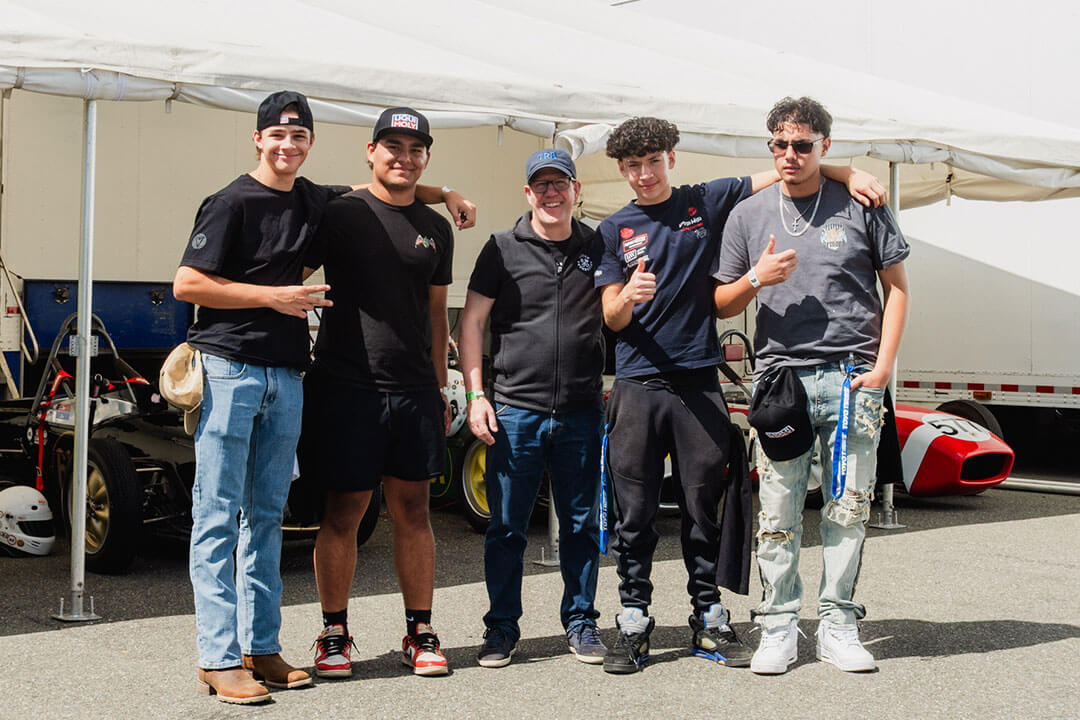Piston Scholar Joe Estevez’s Dream Career hits the Digital “Car-Scape”
Joe Estevez, the 20-year-old student at Palm Beach (Florida) State College who was awarded a Piston Scholarship in 2023 fell in love with cars and auto racing as a 5-year-old growing up in Florida, going to such races as the Sebring 12-hour and the Daytona 24-hour in the company of his race-car driver dad, Jose.
It didn’t take long before he was immersed in the world of computer design, taking his love of vintage and classic racing cars into a whole new world of technology that would blow the minds of most of the older generation. For the youngsters, it’s become simply routine.
Many have predicted that AI would soon take over the world. Computers are now an everyday device in the homes of just about every citizen, and cellphones have replaced those clunky landline contraptions with that tangly cord.
Creating car parts on a 3D printer was unheard of when today’s vintage and classic cars were originally manufactured. And, now, that crazy concept is what’s launched Estevez and his dream into the future.
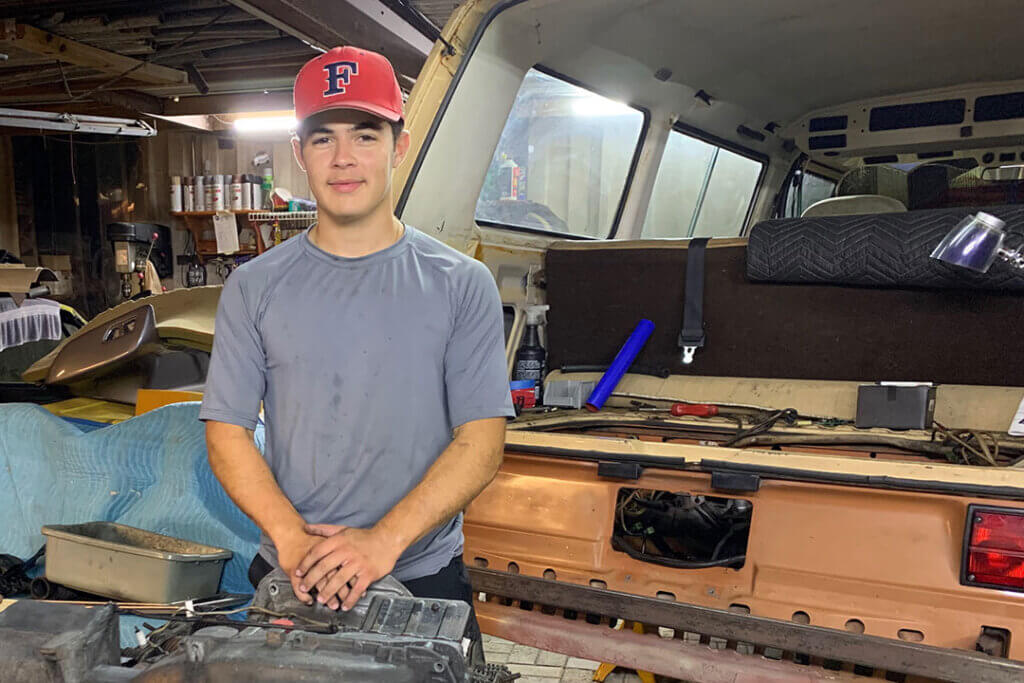
By Judy Stropus
May 28, 2024
[addthis tool=”addthis_inline_share_toolbox_a1tk”]
Like Father, Like Son
“My dad started racing professionally in 1995 with Alex Job Racing and ever since then he’s been working with and for Porsche Motorsports to race in IMSA,” said Estevez.
“My birthday is usually around the weekend of the Sebring 12-Hour race, and, since I was born I’ve been going to race tracks,” he added. “It’s been about five years now that I’ve actually been learning and working with engineers, mechanics and really getting hands-on with racing and the cars.”
Being at race tracks is a highlight of his young life. “It’s an adrenaline rush every time you see the cars and you hear them, and see the speeds that they go around the corners. It was always super exciting to see the competition on the race track,” he said.
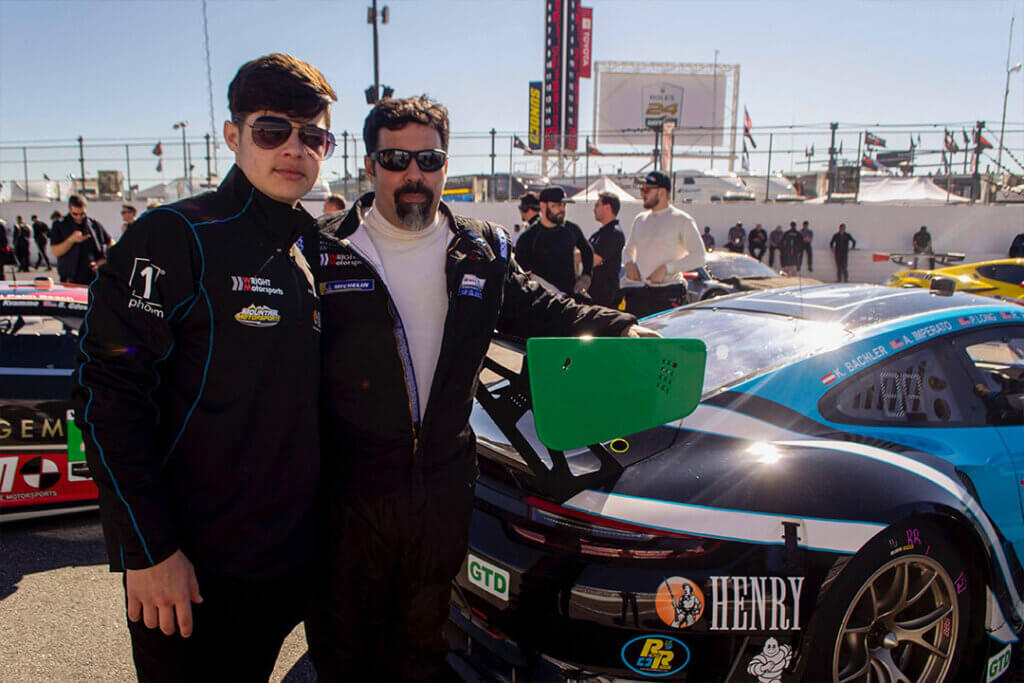
Cars in the Digital Landscape
That passion led to his interest in how cars worked and how today’s technology could be used in restoring vintage cars and making race cars go faster and perform better. “I started to understand how the new technology is being applied to racing nowadays and to the restoration of historic cars. Designing and CAD (Computer-Aided Design) programs have been around a lot longer, but I discovered them about three or four years ago and began to mess around with it,’ said Estevez.
“I downloaded them on my computer and I started learning the fundamentals of designing and what it takes essentially to build these race cars that I remember seeing as a little kid.”
Piston has been great in all aspects, from answering questions to being able to assist…in schooling and funding. Anyone looking to get their foot in the door in the automotive restoration industry should know that there’s a lot of knowledgeable people at Piston who can help.
~ Joe Estevez, 2023 Piston Scholar
So, while attending college first to earn an associate’s degree, then switching to the machining technology program, thanks to the scholarship he was awarded by The Piston Foundation, Joe began “every day on my own time at home, with nobody teaching me, just learning the programs. I learned about Fusion 360, which is great for CAD and design modeling.
“Then, in school I took the next step forward. I was looking to not only design a part but make a part. So, I learned about other software for CNC (computer numerical control) machine programming to then be able to manufacture parts. I fell in love completely with designing and manufacturing and being able to take something from an idea in somebody’s head to a physical part made. That’s a lot of what goes into the race cars nowadays.”
Customizing for the Classics
This discipline led him on his career path: creating parts for not only vintage and classic cars but newer cars as well. “A lot of the older car parts are harder to come by and they’re becoming more and more expensive. For those parts that aren’t available I’m looking to be able to design parts either as ‘original’ parts or a ‘little off,’ custom, or enhanced.
“And then, if anything comes up down the road where I’m able to design and invent new stuff and work in that field, then that would be a great opportunity.”
So far, he’s constructed parts out of aluminum, steel, titanium, and “parts that need to withhold high temperatures, and I look to be able to do anything and everything wherever my skills are needed,” he said.
Recently, Estevez started on a mission to create his first hood ornament on a 3D printer. “I’ve been working on a hood ornament that belonged to a 1946 Plymouth and nobody in the world makes them anymore,” he explained. “The original was sent to me and I 3D-scanned the original part. I was able to reverse engineer or design it on the CAD program, and go into a 3D model slicing program for 3D printing. Soon I’ll have an exact replica.”
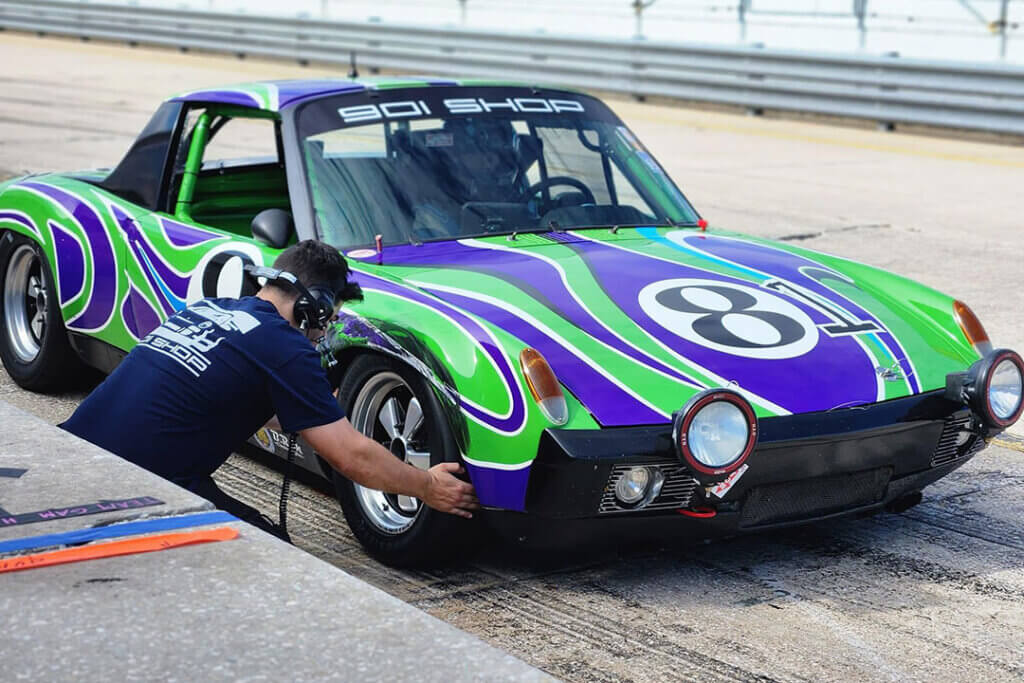
From the Ground to the Air
Not surprisingly, the opportunity he was seeking surfaced in the aerospace field. He is graduating this summer and will continue to work at Baker Hill Industries in Coral Springs, Florida, where he’s worked while attending college. “They were very fascinated by how much passion I had and how much energy I brought to the table and how much I loved designing and manufacturing,” he said. “So we were able to work something out and I work there full-time, manufacturing parts and programming and designing parts.
“Although it’s not in the automotive field, I took the opportunity because of how precise the parts that they make are. And I think I could benefit from everything I’m learning now to be able to apply it to the automotive industry down the road.”
Estevez hopes to eventually run his own restoration shop, but he’s aware of the challenges that face him. “There have been many challenges,” he said. “I didn’t want them to hold me back or to stop me. New technology, from afar, looks very complicated. It looks like it takes lots of experience to learn and to work with. But I feel that I tackled it head on and that’s what was able to give me the fundamentals of learning to design and what it takes to make a part that actually works, not just a part that looks good on a computer. I tried to not look at them as challenges but as stepping stones that once I was able to understand them I could continue moving forward.”
The Future is 3D
Currently, Estevez drives a 1998 Toyota Camry and is restoring a 1983 Volkswagen bus with a Porsche 911 engine. “I’ve made transmission mounts for the engine, and I’ve made a lot of cosmetic parts for the interior of the bus that are hard to come by,” he said. “Such as coat hangers and rails for the curtains. It’s a tight fit putting a six-cylinder engine in a four-cylinder chassis, but Porsche accomplished it in the ‘80s, so I know it’s possible, and I look to add custom or unique parts and features to it to make it my own.”
And what does he use to make these parts? 3D Printers!
He has several 3D printers. The largest part he’s created so far is “10 inches by six inches,” he said. “The more I use them the more I get to understand how they work. So, we’re able to manufacture parts faster, better, and [create] more complicated parts also.
“They’re very affordable these days.”
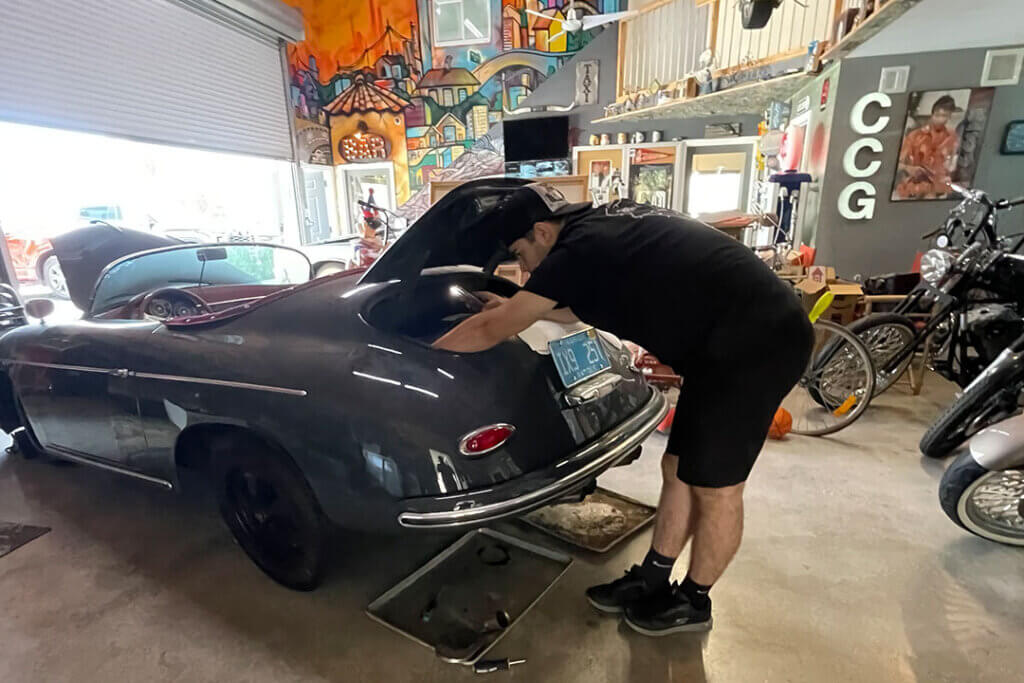
Powerful Perks from the Piston Scholarship
He discovered The Piston Foundation’s scholarship program after meeting Mayo Smith, the organization’s Director of Donor Relations, in Watkins Glen (N.Y.) International race track last year, while working for a race team. “I was speaking with one of the drivers about my passion for designing and about considering going to school, and Mr. Mayo Smith walked by, stopped and turned around and said, ‘Are you currently going to school or you wanted to go to school?’ So he introduced me to The Piston Foundation and two months later the program started at the college and funding was something that I had trouble with to convince me to start going to school. So, after [applying for the scholarship and getting it] I was able to have an amazing opportunity to go to school and start the program.
“Piston has been great in all aspects, from answering questions to being able to assist, obviously in schooling and funding. Anyone looking to get their foot in the door in the automotive restoration industry should know that there’s a lot of knowledgeable people at Piston who can help.”
Today’s generation of young technicians with experience and wherewithal to work on older cars is almost a rarity. It is Piston’s goal to help more students learn the skills of car restoration. “Obviously, our generation grew up with a lot of technology available, and I believe that technology could be used in the classic car restoration industry,” Estevez said. “Back in the ‘60s and ‘70s and even in the ‘50s, everything was word of mouth. Nowadays there aren’t many of those people [still around] who knew those cars. It’s getting harder and harder to find those people who are knowledgeable [about] those vehicles. Now, with the use of technology, there’s many different ways to find pictures, notes, files, and wiring diagrams to be able to restore classic cars exactly the way they left the factory in those early days. I think being able to apply today’s technology will definitely lure in the newer generation to work in the field.”
[addthis tool=”addthis_inline_share_toolbox_a1tk”]
Donate
Today
Support skilled trade education for future auto restoration technicians.
Campaigns
Join Your Peers and Make a Difference
The Founders Club is a unique group of car enthusiasts and collectors who are helping us provide skilled trade education and create career opportunities in the collector car industry.
Give Your Car Collection More Meaning
Donating your collector car or rare parts to the Piston Foundation will support the education of the young technicians and mechanics needed to ensure their future enjoyment.
Make an Impact in the Car Community
Join our Partner Program to connect the charitable giving of your business with the grassroots needs of the car community and workforce development in automotive skilled trades.
Join Your Peers and Make a Difference
The Founders Club is a unique group of car enthusiasts and collectors who are helping us provide skilled trade education and create career opportunities in the collector car industry.
Give Your Car Collection More Meaning
Donating your collector car or rare parts to the Piston Foundation will support the education of the young technicians and mechanics needed to ensure their future enjoyment.
Make an Impact in the Car Community
Join our Partner Program to connect the charitable giving of your business with the grassroots needs of the car community and workforce development in automotive skilled trades.
Subscribe
Sign up for our monthly email with stories, updates, and volunteer opportunities.

